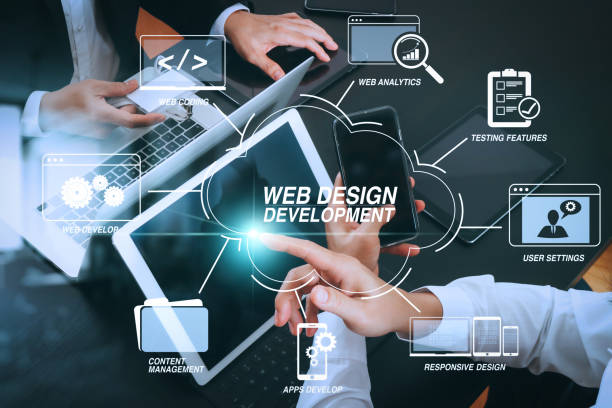Essential Tips for Creating a High-Impact Web Design for Your Business
Essential Tips for Creating a High-Impact Web Design for Your Business
Blog Article
Elevate Your Online Presence With Spectacular Internet Design Tips and Trends
The interplay of visual allure, existing layout fads, and individual experience plays an essential duty in accomplishing this goal. The subtleties of reliable style expand beyond visual appeals; recognizing essential methods for optimization can substantially affect your success.
Relevance of Visual Charm
This figure emphasizes the essential duty that aesthetics play in customer interaction and retention. Effective aesthetic style incorporates aspects such as shade plans, images, typography, and layout, all of which contribute to a attractive and natural user experience.
Furthermore, an aesthetically attractive web site imparts a feeling of trustworthiness and professionalism. Users are more probable to rely on a website that looks well-structured and polished, which can significantly influence conversion rates. On the other hand, a messy or unappealing style can bring about high bounce prices, as customers might regard the web site as unreliable or outdated.
Furthermore, the aesthetic aspects of a site can share brand identification and values (Web design). Constant use of branding components, such as logos and color combinations, enhances recognition and cultivates a deeper link with the audience. Finally, focusing on aesthetic charm is important for creating engaging, trustworthy, and brand-aligned online experiences that reverberate with customers
Existing Style Trends
Modern web design is continuously progressing, and remaining upgraded with existing patterns is important for producing impactful on the internet experiences. One popular pattern is the surge of minimalism, characterized by clean lines, sufficient white space, and a focus on crucial components. This method not just enhances usability yet also permits web content to take center stage.
In addition, dark setting user interfaces have actually gotten popularity, providing individuals with an aesthetically striking choice while minimizing eye strain. This fad aligns well with user preferences, using a modern-day visual that is both elegant and practical.
One more noteworthy pattern is the incorporation of vibrant typography. Developers are progressively using huge, expressive typefaces to create visual power structure and share brand name messages properly. Combined with dynamic shade schemes, this pattern adds dynamism to web pages.

Crucial Style Aspects
Effective web layout depends upon a number of vital style aspects that with each other develop a engaging and natural user experience. The initial of these aspects is format, which dictates exactly how material is organized on the web page. A well-structured format not only enhances readability but also guides users through the website effortlessly.
Shade plays a vital function in style, affecting emotions and brand assumption. An unified shade palette can stimulate certain sensations and develop an aesthetic power structure, thereby drawing interest to vital elements. Similarly, typography is important; the selection of typefaces must straighten with the brand name identification and make certain legibility across tools.
Furthermore, whitespace is commonly overlooked but is crucial for creating balance. It helps stop clutter, enabling customers to concentrate on the vital aspects without diversion.
Finally, consistency throughout all style aspects reinforces brand name identity and makes navigation intuitive. By carefully including these important style aspects, web developers can produce visually appealing and practical sites that captivate visitors and motivate communication.
Individual Experience Optimization
A seamless customer experience is crucial for maintaining site visitors and driving conversions on a website. Maximizing user experience (UX) includes recognizing your audience and tailoring design aspects to satisfy their requirements successfully. Trick parts of UX optimization consist of intuitive navigation, fast loading times, and reference clear contact us to action.
Include breadcrumb tracks to aid users conveniently backtrack, reducing aggravation. Rate is another crucial element; websites ought to load within 3 secs to protect against customers from abandoning the website.
Furthermore, your website's style should focus on clearness. Use clear font styles, contrasting colors, and whitespace to develop a visually attractive layout that guides customers via content effortlessly. Contact us to action need to be plainly presented, utilizing actionable language that motivates individuals to engage.
Mobile Responsiveness Techniques
Nearly fifty percent of all web traffic now like this originates from smart phones, highlighting the relevance of carrying out durable mobile responsiveness approaches. To make sure optimal user experience across numerous display dimensions, web designers must welcome a fluid grid format that adapts perfectly to various tools. This approach enables material to resize and rearrange without jeopardizing capability or aesthetics.
Including flexible images and media queries is necessary. Pictures must immediately readjust their size according to the viewport, while media questions can identify tool attributes and apply customized CSS designs as necessary. This technique improves load times and ensures that customers have a visually enticing experience.
Furthermore, focus on touch-friendly navigation elements. Buttons and web links ought to be quickly tappable, with appropriate spacing to stop misclicks. Preventing hover-dependent communications additionally enhances functionality on touchscreens.
Lastly, carrying out normal testing across different devices and browsers is critical. Tools like Google's Mobile-Friendly Examination can aid identify locations requiring click resources improvement. By embracing these mobile responsiveness methods, companies can boost individual engagement, boost search engine rankings, and eventually drive conversions, consequently boosting their on-line existence successfully.
Final Thought
By prioritizing visual charm via current style fads and necessary components, companies can foster integrity and engagement. Optimizing individual experience and making sure mobile responsiveness are vital for assisting in seamless interaction across gadgets.

Conversely, a cluttered or unattractive design can lead to high bounce rates, as users may view the site as unreliable or outdated. - Web design
Effective web layout pivots on a number of necessary design elements that together create a cohesive and engaging individual experience. Maximizing individual experience (UX) involves recognizing your audience and customizing design components to fulfill their demands successfully.
Report this page